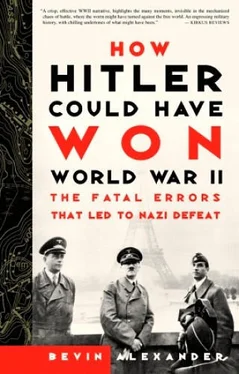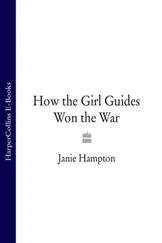DURING THE FRANTIC FIRST DAYS OF THE CAMPAIGN, SOVIET OFFICIALS TRANSFERRED 1,500 factories and as much machinery as possible, along with workers, by rail to the Urals and western Siberia. This exhausting, chaotic undertaking resulted in enormous drops in production and terrible living conditions for workers, but ensured that Soviet industry would ultimately recover and produce weapons and war goods in great quantities. In the interim, much depended on the willingness of the west to support the Soviet Union.
In the United States and Britain there was doubt that Russia could last out the summer. Americans in general were gleeful that the world’s two worst dictatorships were tearing at each other’s vitals and hoped they would fight to mutual exhaustion. President Roosevelt and Prime Minister Churchill, however, were terrified that Hitler would win and the democracies would be faced with the combined resources of Europe and the Soviet Union.
Roosevelt’s first reaction to Soviet pleas for help was caution, and he dodged questions from the press about extending lend-lease to Russia. But he quickly decided that aiding the Red Army might be worth the gamble, and in mid-July sent his closest confidant, Harry Hopkins, to London to discuss the matter with Churchill.
Churchill endorsed American help to Russia, but he didn’t like the idea of supplies destined for Britain being diverted to the Reds. Hopkins decided to go to Moscow himself to assess the situation. The trip was long and hard, but in Moscow Hopkins found confidence, high morale, and “unbounded determination to win.” Stalin vowed he’d fight beyond the Ural Mountains even if Moscow fell.
At the moment the United States was as preoccupied with Japan as it was with Hitler’s advances into the Soviet Union. On July 2, at a secret imperial conference in Tokyo, Japanese leaders decided not to join the war against Russia, unless the Red Army collapsed. Instead they elected to continue their drive south to seize most or all of Southeast Asia, overrunning the colonies of the Netherlands, France, and Britain. Shortly after France’s defeat in 1940, the Japanese demanded and got permission to occupy northern French Indochina (Vietnam, Laos, and Cambodia).
The Kremlin knew the results of the July 2 conference from its spy in Tokyo, Richard Sorge. But Stalin took no chances. Though he desperately needed the thirty divisions, many tanks, and 2,800 warplanes he had in the Far East, he kept most in place, and actually strengthened defenses around Manchuria, where the Japanese army was massed.
This sealed Japan’s decision to move south, and on July 14 the government demanded of the Vichy French agreement to occupy eight air bases in southern Indochina and to use France’s naval base at Camranh Bay. The French quickly capitulated.
FDR and Cordell Hull, secretary of state, didn’t know of the imperial conference, but were aware of much that was going on in Tokyo. American army and navy cryptanalysts by August 1940 had discovered the secrets of the Japanese encoding machine known as “Purple,” which diplomats used in radio messages to and from Tokyo. American intercepts of these messages in the decoding program named “Magic” picked up indications of Japanese intentions in Southeast Asia.
This galvanized Roosevelt into taking a step on July 25, 1941, which he had shrunk from for over a year: he froze Japanese assets, instantly ending all trade with Japan. Britain, its dominions, and the Dutch East Indies followed quickly.
Roosevelt and Churchill hoped this action would slow the Japanese drive toward war, but it actually accelerated it. Without oil imports from the United States or the East Indies, Japan’s military operations would collapse within months. The army and navy started preparing for armed confrontation.
Hopkins got back to London from Moscow just in time to climb aboard the British battleship Prince of Wales taking Churchill and his staff to meet Roosevelt at Placentia Bay, Newfoundland—the Atlantic Conference on August 9–12, 1941, and the first meeting of the two leaders. Hopkins told FDR that all-out aid to Russia was a good bet. At the worst it would delay Hitler long enough for the United States to prepare for war. He recommended that the Soviets be declared eligible for lend-lease.
Roosevelt sent Stalin a message promising strong aid after three months. FDR’s decision was influenced by the fear that Stalin might conclude a peace with Hitler, something hardly less bad than a German victory.
As Churchill turned back toward Britain, a de facto anti-Hitler coalition had been sealed. On the last day of the conference, August 12, 1941, the House of Representatives extended the draft by a single vote, 203–202. Narrow as the vote was, it demonstrated American determination to rearm and defend itself. Freezing trade with Japan was one sign of this resolve, and Roosevelt did more: he extended U.S. Navy protection of British convoys to Iceland and prepared deliveries to the Soviet Union along this route.
On August 25, Britain and the Soviet Union occupied Iran and ensured an all-weather, unopposed supply line to Russia. Soviet forces from the north and British from the south took over the country, required Shah Reza Pahlevi to abdicate in favor of his son, and mobilized forced labor to build a highway between Shatt al Arab and the Caspian Sea to expedite American exports.
When Guderian’s panzer group moved south to assist in the Kiev caldron battle, Hitler sent Hermann Hoth’s panzer group to join Army Group North’s efforts to seize Leningrad. But the Finns refused to press down from the north beyond their old prewar boundary. Half a million of the city’s three million people helped to build fortifications around the city— 620 miles of earthworks, 400 miles of antitank ditches, thousands of concrete pillboxes.
German panzers were able to seal off the southeastern approaches to the city, the only land bridge to the rest of Russia. This put the city under siege, but left open a water route east of the city across Lake Ladoga. The situation for the people was grim, but there was no thought of surrender. In mid-September Georgy K. Zhukov, dismissed as chief of staff because he had advised Stalin to abandon Kiev, arrived with orders to hold the city.
Zhukov brought up every gun and mortar available to blast the Germans and prevent penetration of the city’s defense line. Leeb informed Hitler on September 24 that his attacks had failed. The Leningrad front slowly subsided into a gruesome siege that lasted until the spring of 1944, killed or starved millions, but had no major effect on the war.
Meanwhile, far to the south, Rundstedt’s army group overran the Donetz basin and, on November 21, seized Rostov on the Don, at the entrance to the Caucasus. But without Guderian’s tanks, he could not drive on the oil fields. The Russians soon pushed his exhausted troops out of the city.
Rundstedt wanted to pull back to a good defensive line along the Mius River, about forty miles west of Rostov, but Hitler forbade the withdrawal. Rundstedt responded that he could not comply with such an order. Contrary to his custom, Hitler came to Rundstedt’s headquarters at Poltava with Brauchitsch and Halder.
Hitler tried to blame Rundstedt for losing Rostov. Rundstedt answered that responsibility must lie with those who devised the campaign. “Hitler looked for a moment as though he were about to hurl himself against Rundstedt, and tear the Knight’s Cross from his uniform,” Walter Goerlitz wrote. Brauchitsch promptly had another heart attack.
Rundstedt persisted in his demands for freedom. When Hitler refused, he asked to be relieved of command. Hitler agreed, but at a final meeting told Rundstedt that in the future he would not consider any request by generals for retirement.
Читать дальше


![Джонатан Димблби - Barbarossa - How Hitler Lost the War [calibre]](/books/385421/dzhonatan-dimblbi-barbarossa-how-hitler-lost-the-w-thumb.webp)









